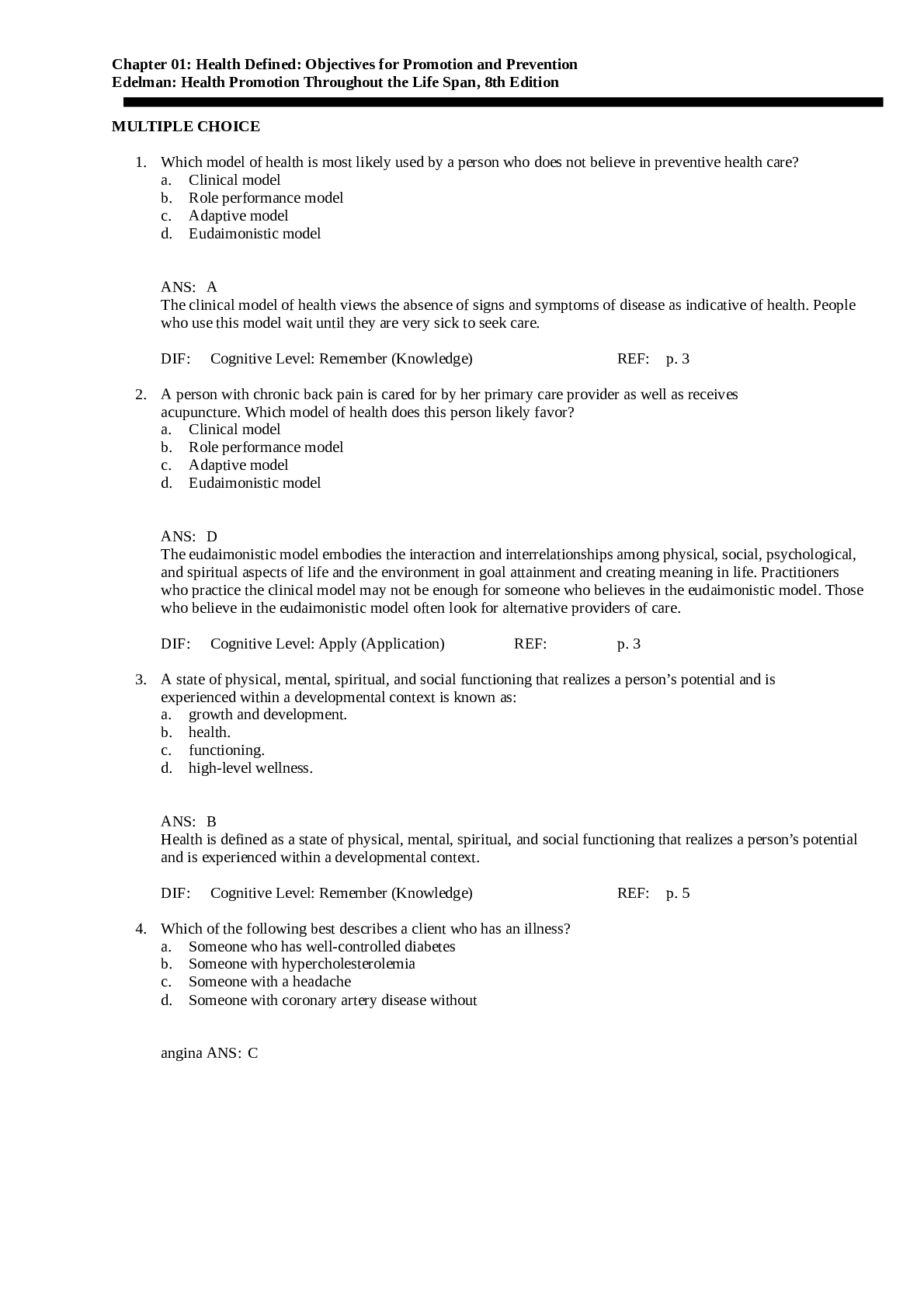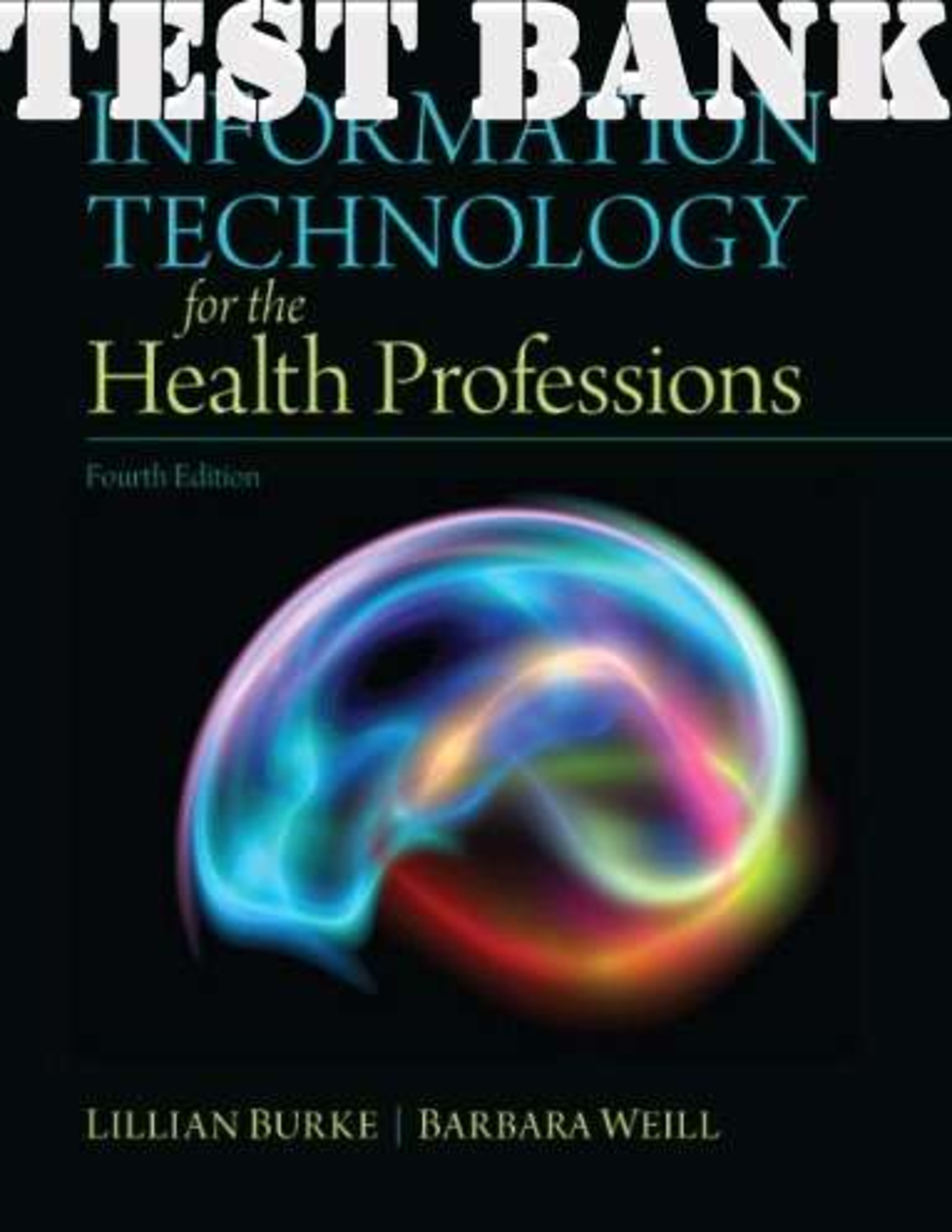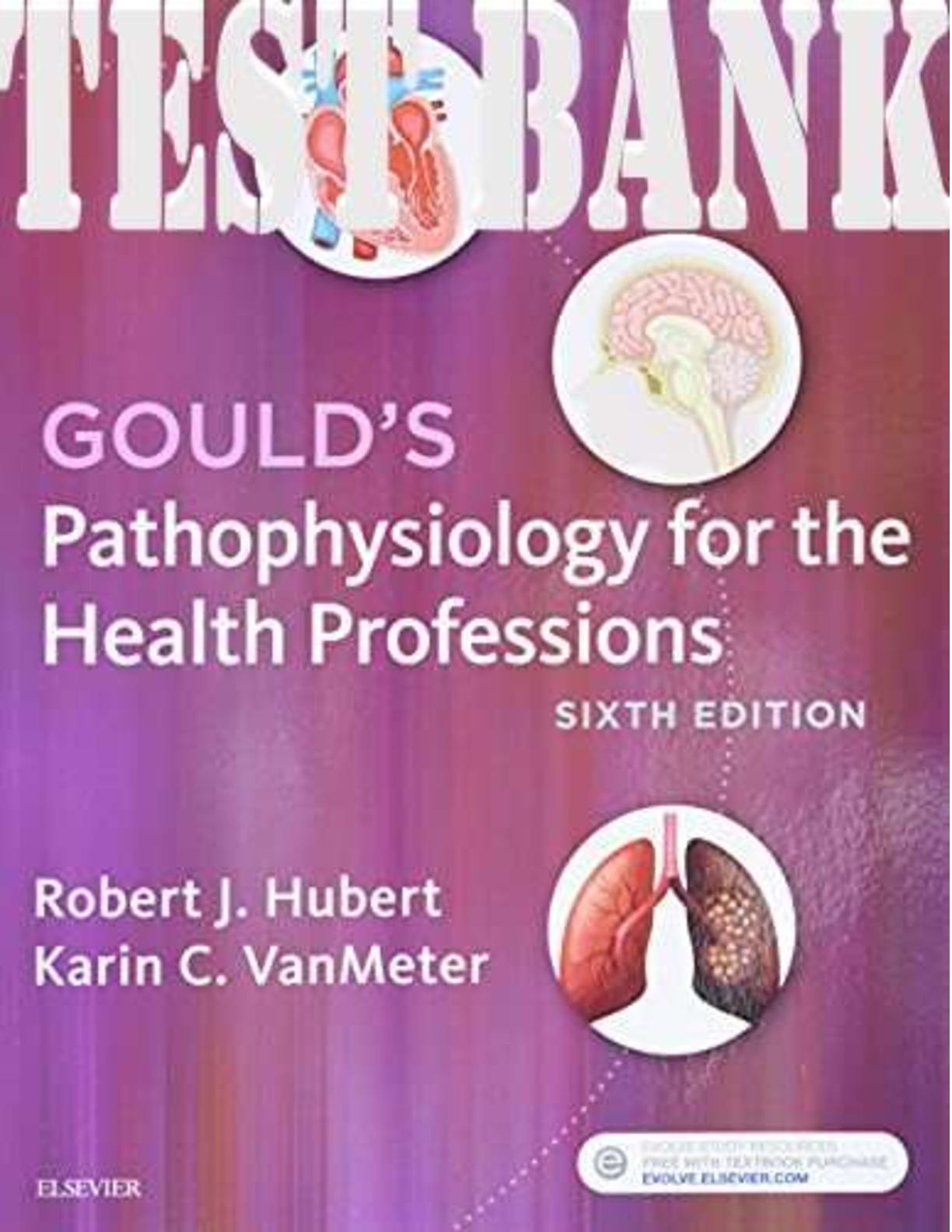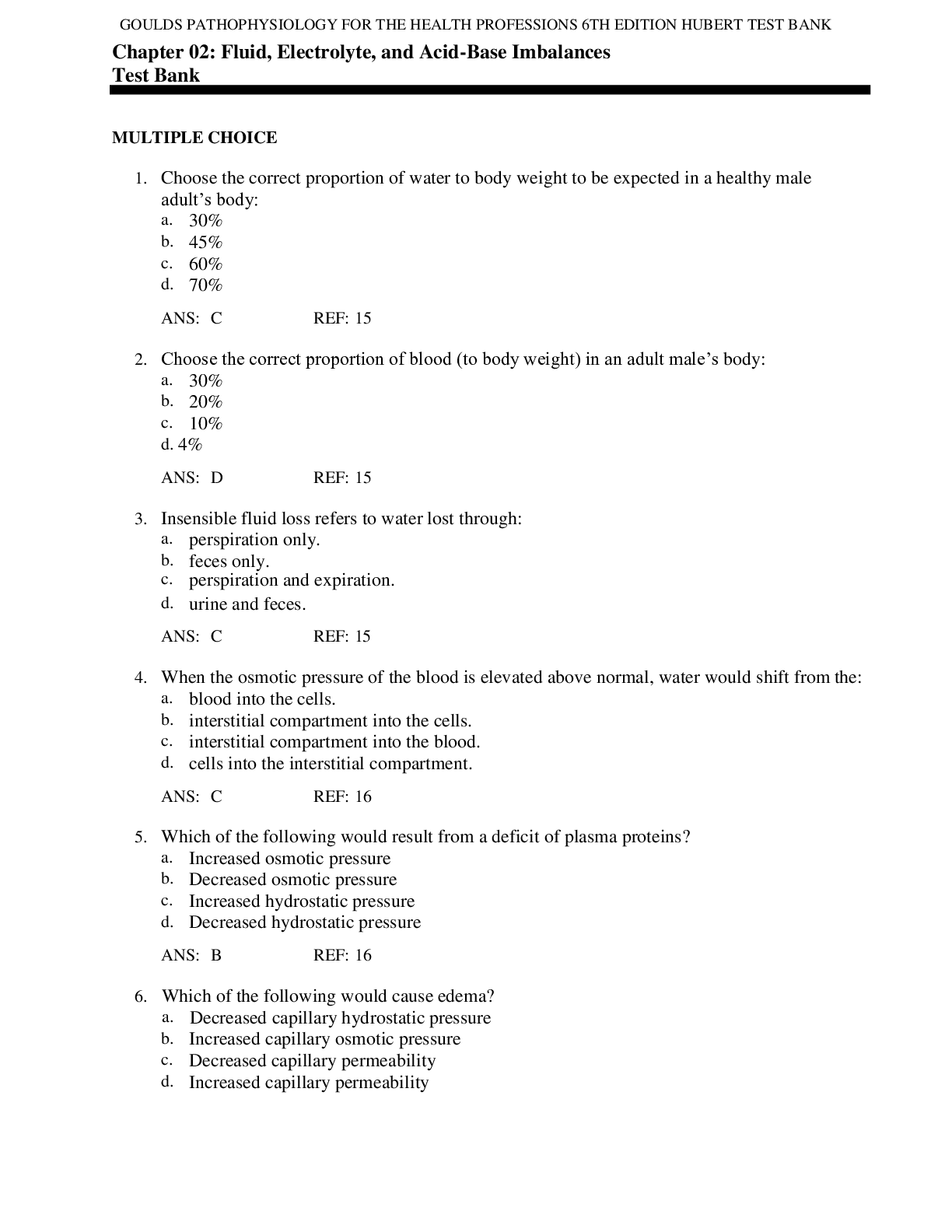*NURSING > TEST BANK > Test Bank For Gould’s Pathophysiology For The Health Professions, 5e 5th Edition | Gould’s Patho (All)
Test Bank For Gould’s Pathophysiology For The Health Professions, 5e 5th Edition | Gould’s Pathophysiology for the Health Professions 5th edition VanMeter Test Bank (All chapters)
Document Content and Description Below
Chapter 01: Introduction to Pathophysiology Test Bank MULTIPLE CHOICE 1. Which of the following would be the most likely cause of an iatrogenic disease? a. An inherited disorder b. A combination... of specific etiological factors c. An unwanted effect of a prescribed drug d. Prolonged exposure to toxic chemicals in the environment 2. The manifestations of a disease are best defined as the: a. subjective feelings of discomfort during a chronic illness. b. signs and symptoms of a disease. c. factors that precipitate an acute episode of a chronic illness. d. early indicators of the prodromal stage of infection. 3. The best definition of the term prognosis is the: a. precipitating factors causing an acute episode. b. number of remissions to be expected during the course of a chronic illness. c. predicted outcome or likelihood of recovery from a specific disease. d. exacerbations occurring during chronic illness. 4. Which of the following is considered a systemic sign of disease? a. Swelling of the knee b. Fever c. Pain in the neck d. 5. Etiology is defined as the study of the: a. causes of a disease. b. course of a disease. c. expected complications of a disease. d. manifestations of a disease. 6. A type of cellular adaptation in which there is a decrease in cell size is referred to as: a. hypertrophy. b. metaplasia. c. anaplasia. d. 7. A change in a tissue marked by cells that vary in size and shape and show increased mitotic figures would be called: 8. A deficit of oxygen in the cells usually due to respiratory or circulatory problems is called: a. apoptosis. b. ischemia. c. hypertrophy. d. 9. When a group of cells in the body dies, the change is called: a. ischemia. b. gangrene. a. metaplasia. b. atrophy. c. dysplasia. d. hypertrophy. c. hypoxia. d. necrosis. 10. Rigorous weight lifting/body building regimens may result in the skeletal muscle cells undergoing: 11. The term cancer refers to: a. dysplasia. b. hyperplasia. c. metaplasia. d. malignant neoplasm. 12. To which of the following does the term apoptosis refer? a. Increased rate of mitosis by certain cells b. Ischemic damage to cells a. hypertrophy. b. dysplasia. c. atrophy. d. regeneration. c. Liquefaction of necrotic tissue d. Preprogrammed cell self-destruction 13. Which of the following statements is TRUE? a. Alteration of DNA does not change cell function. b. Damaged cells may be able to repair themselves. c. All types of cells die at the same rate. d. Mild ischemia causes immediate cell death. 14. Caseation necrosis refers to an area where: a. cell proteins have been denatured. b. cell are liquefied by enzymes. c. dead cells form a thick cheesy substance. d. bacterial invasion has occurred. 15. Routine application of sun block to skin would be an example of: a. an iatrogenic cause of cancer. b. a preventive measure. c. a precipitating factor. d. a predisposing condition. 16. A circumstance that causes a sudden acute episode of a chronic disease to occur is termed: a. latent stage. b. predisposing factor. c. incidence. d. precipitating factor. 17. The term homeostasis refers to: a. the causative factors in a particular disease. b. maintenance of a stable internal environment. c. a condition that triggers an acute episode. d. a collection of signs and symptoms. 18. Which term is used to describe a new and secondary or additional problem that arises after the original disease has been established? a. Symptoms b. Occurrence c. Manifestations d. Complication 19. Pathophysiology involves the study of: a. the structure of the human body. b. the functions of various organs in the body. c. functional or structural changes resulting from disease processes. d. various cell structures and related functions. 20. Which of the following is the best definition of epidemiology? a. The science of tracking the occurrence and distribution of diseases b. The relative number of deaths resulting from a particular disease c. Identification of a specific disease through evaluation of signs and symptoms d. The global search for emerging diseases 21. Which of the following can cause cell injury or death? 1. Hypoxia 2. Exposure to excessive cold 3. Excessive pressure on a tissue 4. Chemical toxins a. 1, 2 b. 2, 4 c. 1, 3, 4 d. 1, 2, 3, 4 22. All of the following are part of the Seven Steps to Health EXCEPT: a. follow cancer screening guidelines. b. use sun block agents whenever exposed. c. participate in strenuous exercise on a regular daily basis. d. choose high fiber, lower fat foods. 23. The term disease refers to: a. the period of recovery and return to a normal healthy state. b. a deviation from the normal state of health and function. c. the treatment measures used to promote recovery. d. a basic collection of signs and symptoms. 24. A collection of signs and symptoms, often affecting more than one organ or system, that usually occur together in response to a certain condition is referred to as a (an): 25. All of the following statements are correct about cell damage EXCEPT: a. The initial stage of cell damage often causes an alteration in metabolic reactions. b. If the factor causing the damage is removed quickly, the cell may be able to recover and return to its nor c. If the noxious factor remains for an extended period of time, the damage becomes irreversible and the ce d. Initially, cell damage does not change cell metabolism, structure, or function. 26. Which of the following conditions distinguishes double blind studies used in health research? a. Neither the members of the control group or the experimental group nor the person administering the trea receiving the experimental therapy. b. Both groups of research subjects and the person administering the treatment know who is receiving the ex c. The research subjects do not know, but the person administering the treatment knows who is receiving pla therapy. d. Only members of the control group know they are receiving standard therapy. a. acute disease. b. multiorgan disorder. c. syndrome. d. manifestation. 27. If the data collected from the research process confirm that the new treatment has increased effectiveness and is safe, this is called: 28. A short-term illness that develops very quickly with perhaps a high fever or severe pain is called: a. acute. b. latent. c. chronic. d. manifestation. 29. The term prognosis refers to the: a. period of recovery and return to a normal state. b. expected outcome of the disease. c. mortality and morbidity rates for a given population. d. typical collection of signs and symptoms. a. the placebo effect. b. evidence-based research. c. blind research studies. d. approval for immediate distribution. 30. When prolonged ischemia occurs to an area of the heart, the resulting damage is referred to as: a. atrophy. b. liquefactive necrosis. c. apoptosis. d. infarction. ANS: D REF: 10 31. During the evaluation process for a new therapy’s effectiveness and safety, a double blind study may be conducted during: 32. Why are the predisposing factors for a specific disease important to health professionals? a. To predict the prognosis b. To determine treatments c. To develop preventive measures d. To develop morbidity statistics a. the first stage. b. the second stage. c. the third stage. d. any of these stages. 33. Cell damage may be caused by exogenous sources such as: a. abnormal metabolic processes. b. certain food additives. c. genetic defects. d. localized hypoxia. 34. Which of the following is usually included in a medical history? 1. Past illnesses or surgeries 2. Current illnesses, acute and chronic 3. Prescribed medication or other treatments 4. Nonprescription drugs and herbal remedies 5. Current allergies a. 1, 3 b. 2, 4, 5 c. 1, 3, 4 d. 1, 2, 3, 4, 5 35. A situation when there is a higher than expected number of cases of an infectious disease within a given area is called a/an: a. epidemic. b. exacerbation. c. morbidity. d. pandemic. 36. The term pathogenesis refers to: a. the development of a disease or sequence of events related to tissue changes involved in the disease proc b. the determination of the cause(s) involved in the development of a malignant neoplasm. c. the specific signs and symptoms involved in the change from an acute disease to a chronic disease. d. the changes in cells of affected tissue that result in necrosis. 02: Fluid, Electrolyte, and Acid- Base Imbalances Chapter 02: Fluid, Electrolyte, and Acid-Base Imbalances Test Bank MULTIPLE CHOICE 1. Choose the correct proportion of water to body weight to be expected in a healthy male adult’s body: a. 30% b. 45% c. 60% d. 70% 2. Choose the correct proportion of blood (to body weight) in an adult male’s body: a. 30% b. 20% c. 10% d. 4% 3. Insensible fluid loss refers to water lost through: a. perspiration only. b. feces only. c. perspiration and expiration. d. urine and feces. 4. When the osmotic pressure of the blood is elevated above normal, water would shift from the: a. blood into the cells. b. interstitial compartment into the cells. c. interstitial compartment into the blood. d. cells into the interstitial compartment. 5. Which of the following would result from a deficit of plasma proteins? a. Increased osmotic pressure b. Decreased osmotic pressure c. Increased hydrostatic pressure d. Decreased hydrostatic pressure 6. Which of the following would cause edema? a. Decreased capillary hydrostatic pressure b. Increased capillary osmotic pressure c. Decreased capillary permeability d. Increased capillary permeability 7. Which of the following would likely be related to an elevated hematocrit reading? a. Fluid excess b. Fluid deficit c. Increased sodium level d. Decreased erythrocytes 8. Which of the following is a typical sign of dehydration? a. Rapid, strong pulse b. Low hematocrit c. Increased urine output d. Rough oral mucosa ANS: D REF: 21 9. Which of the following terms refers to a combination of decreased circulating blood volume combined with excess fluid in a body cavity? 10. Which of the following is the primary cation in the extracellular fluid? a. Sodium b. Potassium a. Dehydration b. Third-spacing c. Hypovolemia d. Water retention c. Calcium d. Iron 11. Which of the following is a common cause of hyponatremia? a. Loss of the thirst mechanism b. Excessive sweating c. Excessive aldosterone secretion d. Prolonged period of rapid, deep respirations 12. Which of the following is a common effect of both hypokalemia and hyperkalemia? a. Skeletal muscle twitch and cramps b. Oliguria c. Elevated serum pH d. Cardiac arrhythmias 13. Choose the correct effect of increased parathyroid hormone. a. Increased movement of calcium ions into the bones b. Increased activation of vitamin D c. Increased absorption of calcium from the digestive tract d. Decreased reabsorption of calcium in the kidneys 14. Which of the following results from hypocalcemia? 1. Low serum phosphate levels 2. Nausea and constipation 3. Skeletal muscle twitch and spasms 4. Weak cardiac contractions a. 1, 2 b. 1, 4 c. 2, 3 d. 3, 4 15. Which of the following causes tetany? a. Increased permeability of nerve membranes due to low serum calcium b. Excess calcium ions in skeletal muscle due to excess parathyroid hormone (PTH) c. Excess calcium ions inside somatic nerves as a result of neoplasms d. Increased stimulation of the nerves in the cerebral cortex 16. In which of the following processes is phosphate ion NOT a major component? a. Bone metabolism b. Metabolic processes involving adenosine triphosphate (ATP) c. Blood clotting d. Acid-base balance 17. Which of the following would be considered normal serum pH? a. 4.5-8 b. 7.0 c. 7.4 d. 8 18. When many excess hydrogen ions accumulate in the blood, what happens to serum pH? The pH: a. decreases. b. increases. c. remains constant. d. varies based on metabolism. 19. What is the slowest but most effective control for acid-base balance? a. Respiratory system b. Buffer systems in the blood c. Kidneys d. Brain 20. Which of the following is essential in order to maintain serum pH within normal range? a. Carbonic acid and bicarbonate ion must be present in equal quantities. b. All excess carbonic acid must be excreted by the kidneys. c. The concentration of bicarbonate ion must remain constant. d. The ratio of carbonic acid to bicarbonate ion must be 1:20. 21. Which is the correct effect on the body of abnormally slow respirations? a. Increased carbonic acid b. Decreased carbonic acid c. Increased bicarbonate ion d. Decreased bicarbonate ion 22. Which condition is likely to cause metabolic acidosis? a. Slow, shallow respirations b. Prolonged diarrhea c. Mild vomiting d. Excessive fluid in the body 23. What would a serum pH of 7.33 in a patient with kidney disease indicate? a. Metabolic alkalosis b. Metabolic acidosis c. Respiratory alkalosis d. Respiratory acidosis 24. Which serum value indicates decompensated metabolic acidosis? a. pH is below normal range b. pH is above normal range c. Bicarbonate level decreases d. Bicarbonate level increases 25. What is the effect on blood serum when excessive lactic acid accumulates in the body? a. Bicarbonate ion levels decrease b. Bicarbonate ion levels increase c. Carbonic acid levels increase d. pH increases 26. The direct effects of acidosis are manifested primarily in the functioning of the: a. Digestive system b. Urinary system c. Nervous system d. Respiratory system 27. Compensation mechanisms in the body for dehydration would include: a. increased antidiuretic hormone (ADH). b. decreased aldosterone. c. slow, strong heart contraction. d. peripheral vasodilation. 28. Which acid-base imbalance results from impaired expiration due to emphysema? a. Metabolic acidosis b. Metabolic alkalosis c. Respiratory acidosis d. Respiratory alkalosis 29. In patients with impaired expiration associated with emphysema, effective compensation for the acid-base imbalance would be: ANS: D REF: 32 30. An anxiety attack often causes hyperventilation leading to: a. increased PCO2. b. decreased PCO2. c. respiratory acidosis. d. metabolic acidosis. 31. One of the factors involved in the increased need for water in infants is: a. increased rate and depth of respiration. b. decreased rate and depth of respiration. c. increased urine pH and decreased serum bicarbonate. d. decreased urine pH and increased serum bicarbonate. a. proportionally smaller body surface area. b. higher metabolic rate. c. smaller respiratory capacity. d. greater surface area of exposed mucous membranes. 32. Compensation for respiratory system depression due to anesthesia and sedation would be: a. decreased reabsorption of bicarbonate ions in the kidneys. b. increased secretion of hydrogen ions into the filtrate. c. increased respiratory rate and depth. d. increased renin secretion. 33. A prolonged state of metabolic acidosis often leads to: a. hypokalemia. b. hyperkalemia. c. hyponatremia. d. hypercalcemia ........................................................CONTINUED......................................................................... [Show More]
Last updated: 1 year ago
Preview 1 out of 421 pages
Instant download

Buy this document to get the full access instantly
Instant Download Access after purchase
Add to cartInstant download
Reviews( 0 )
Document information
Connected school, study & course
About the document
Uploaded On
Jun 08, 2021
Number of pages
421
Written in
Additional information
This document has been written for:
Uploaded
Jun 08, 2021
Downloads
1
Views
78

.png)
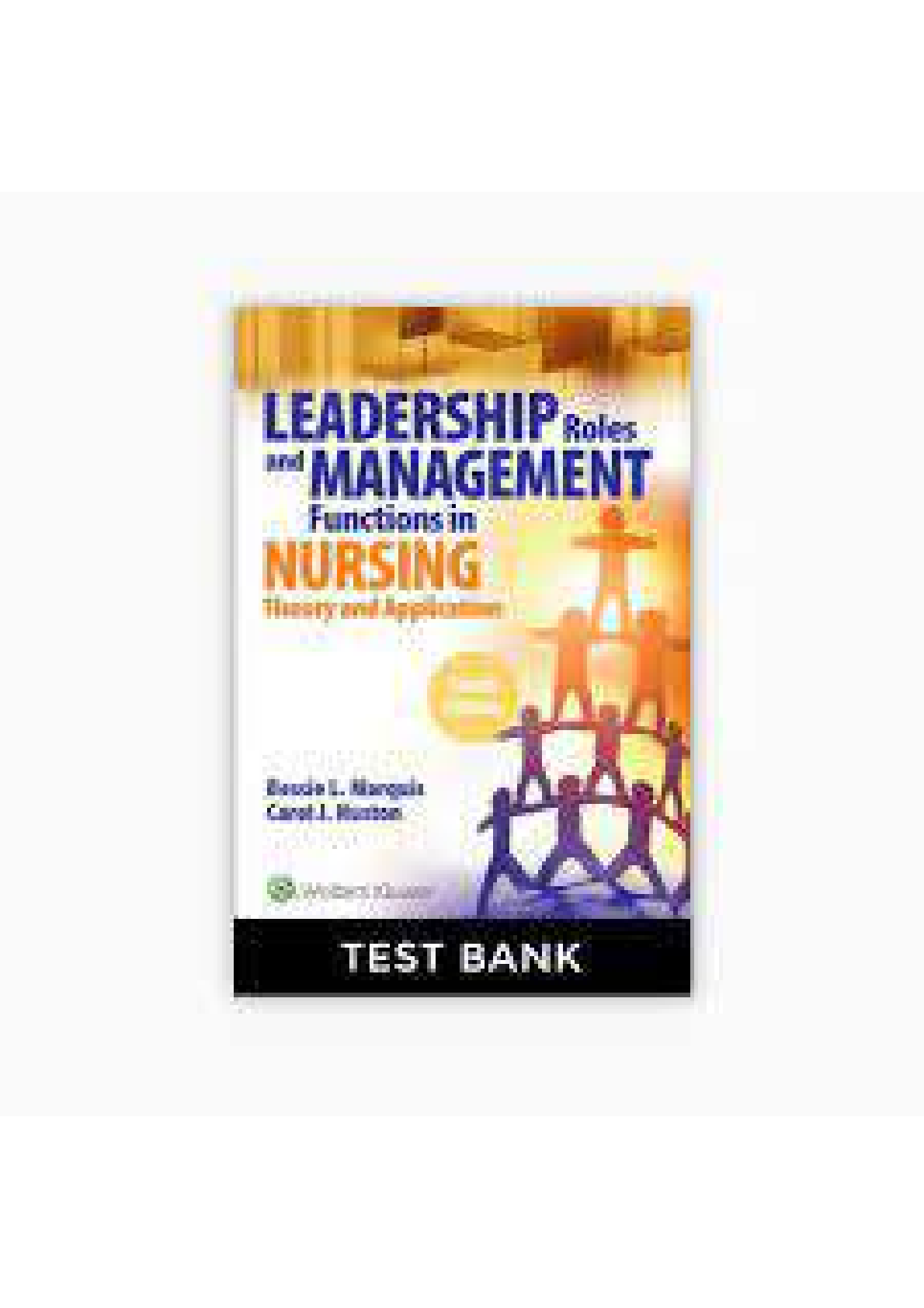
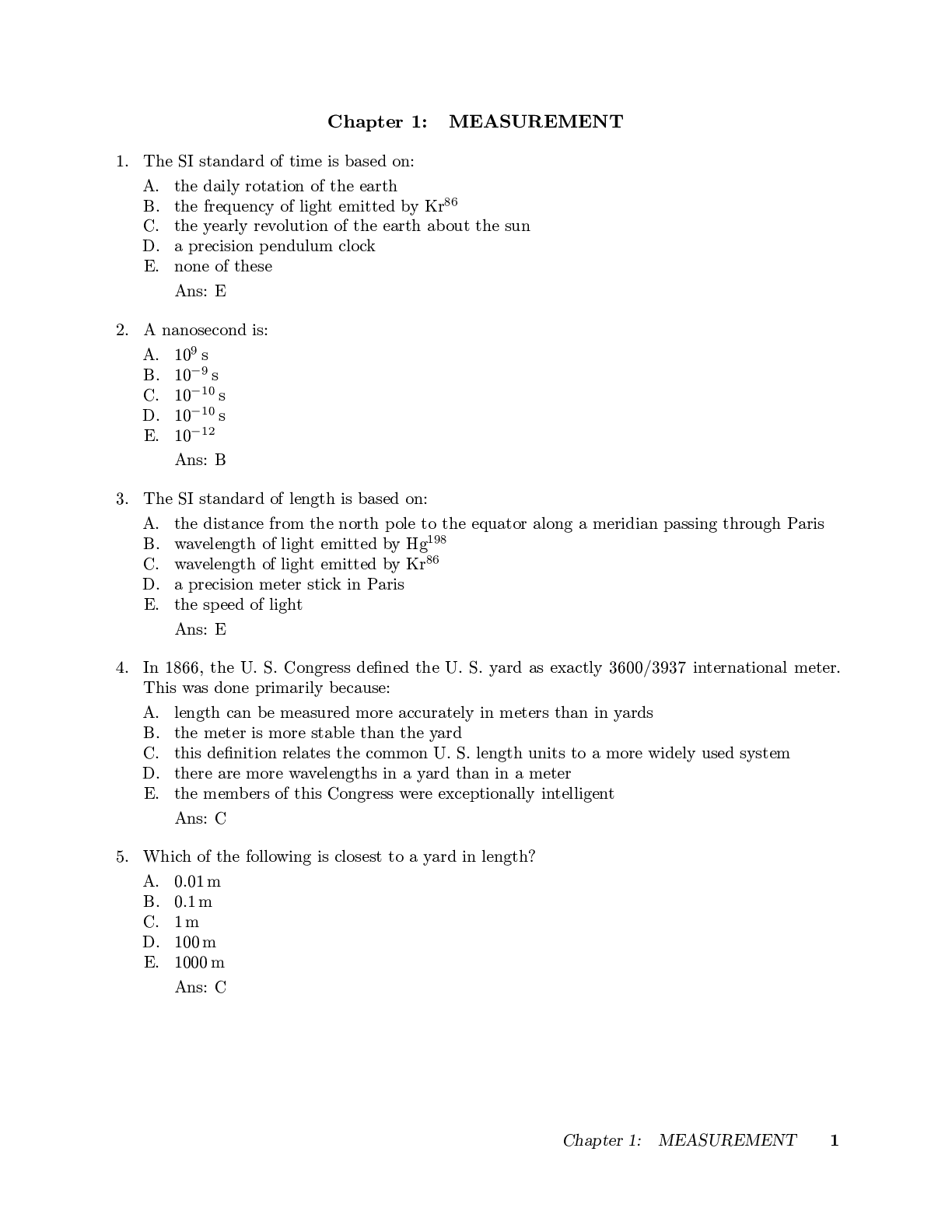
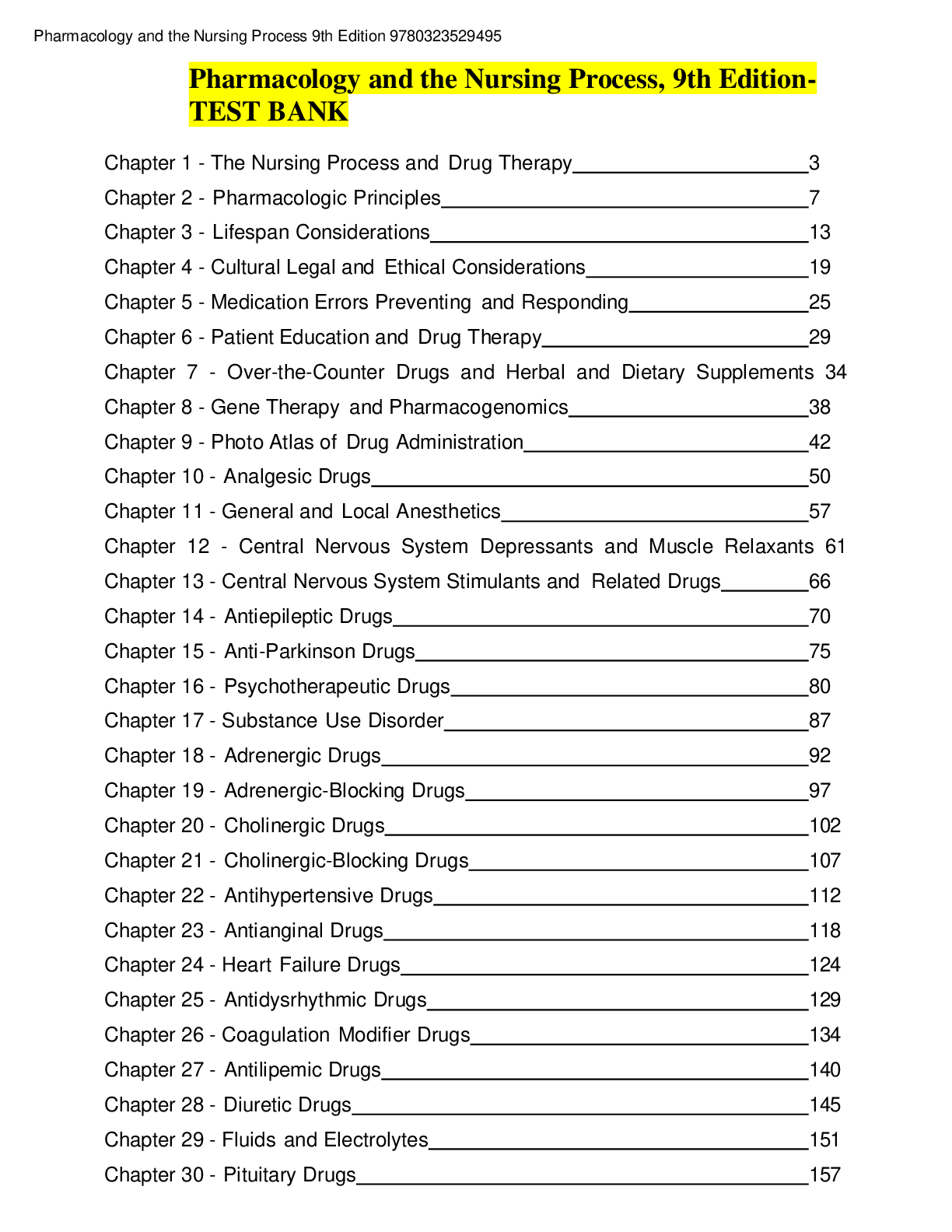


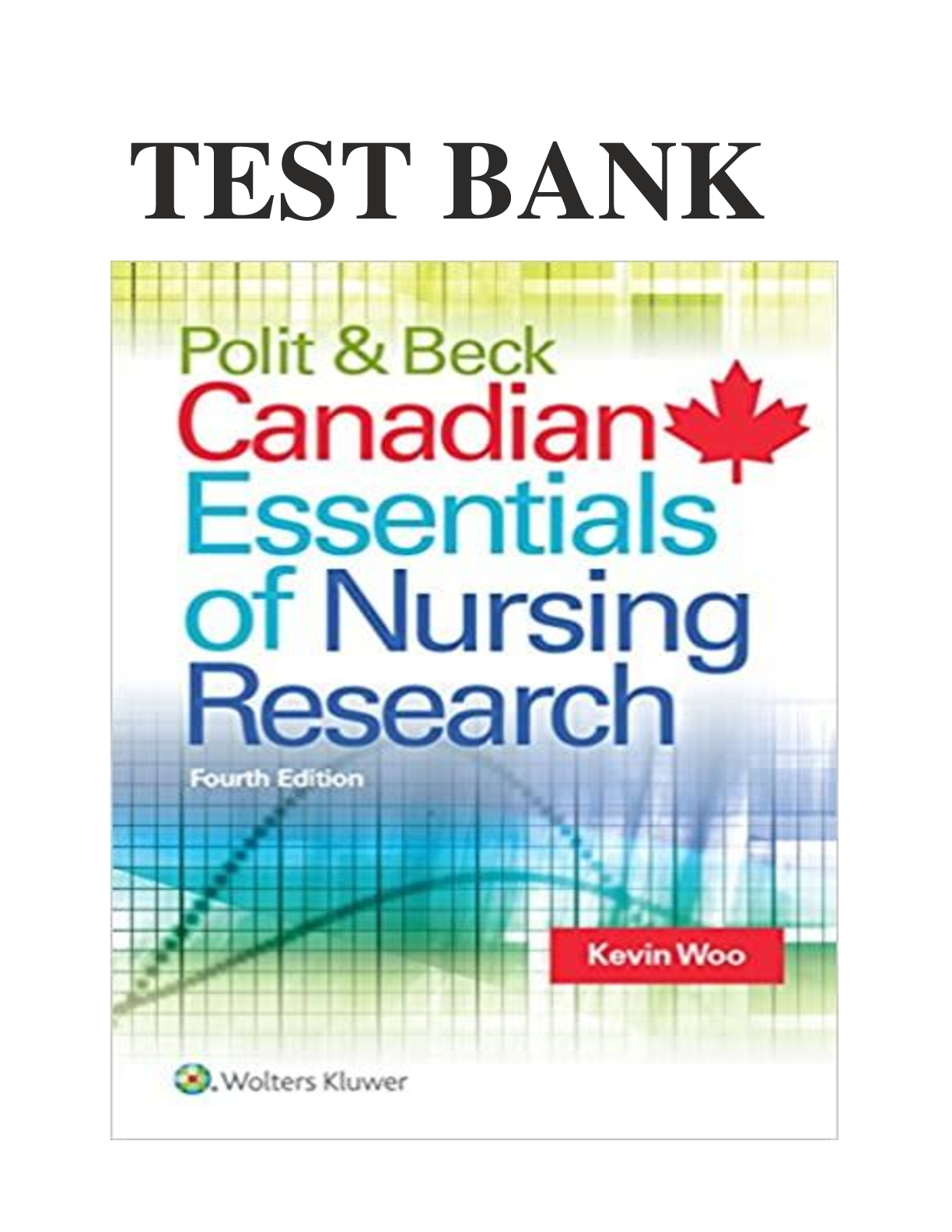
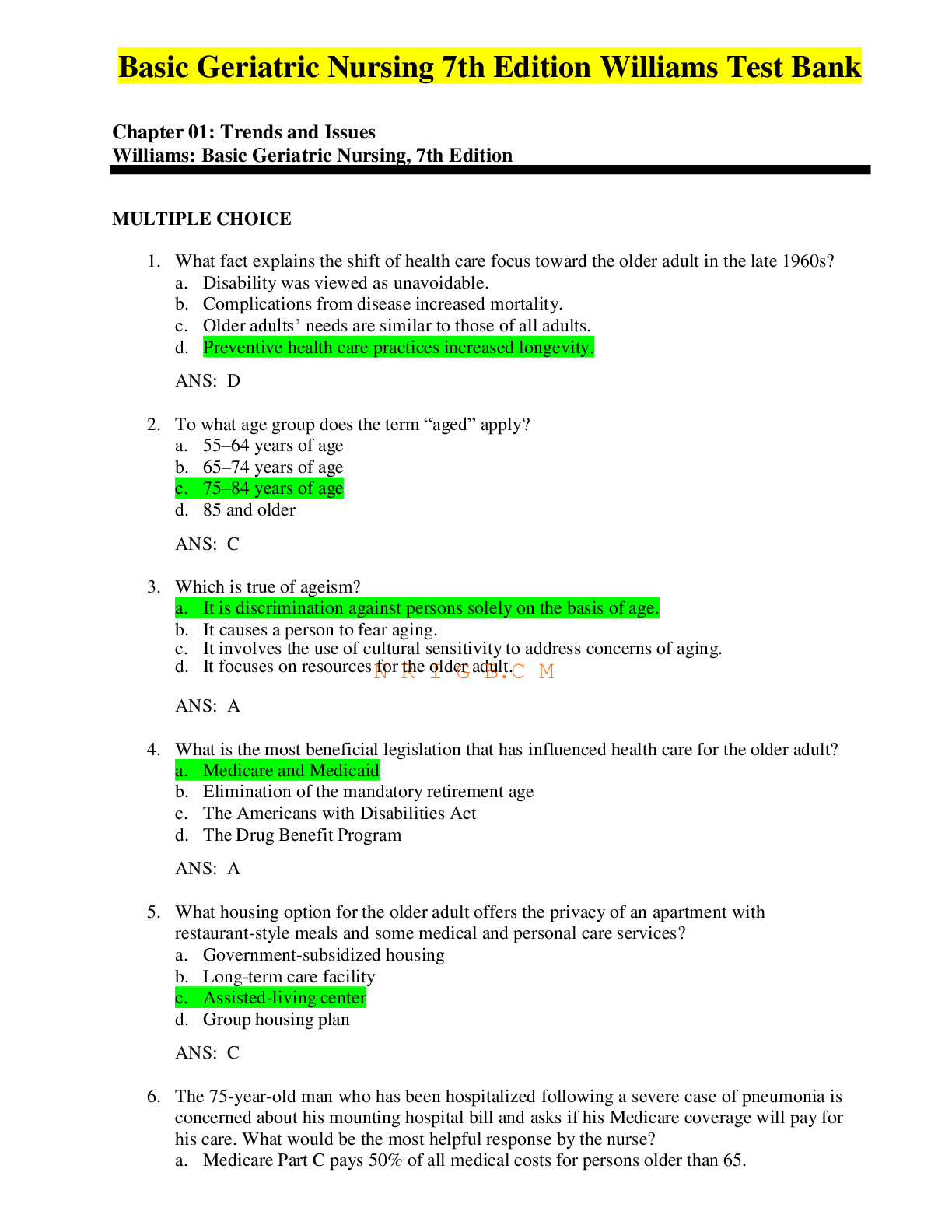
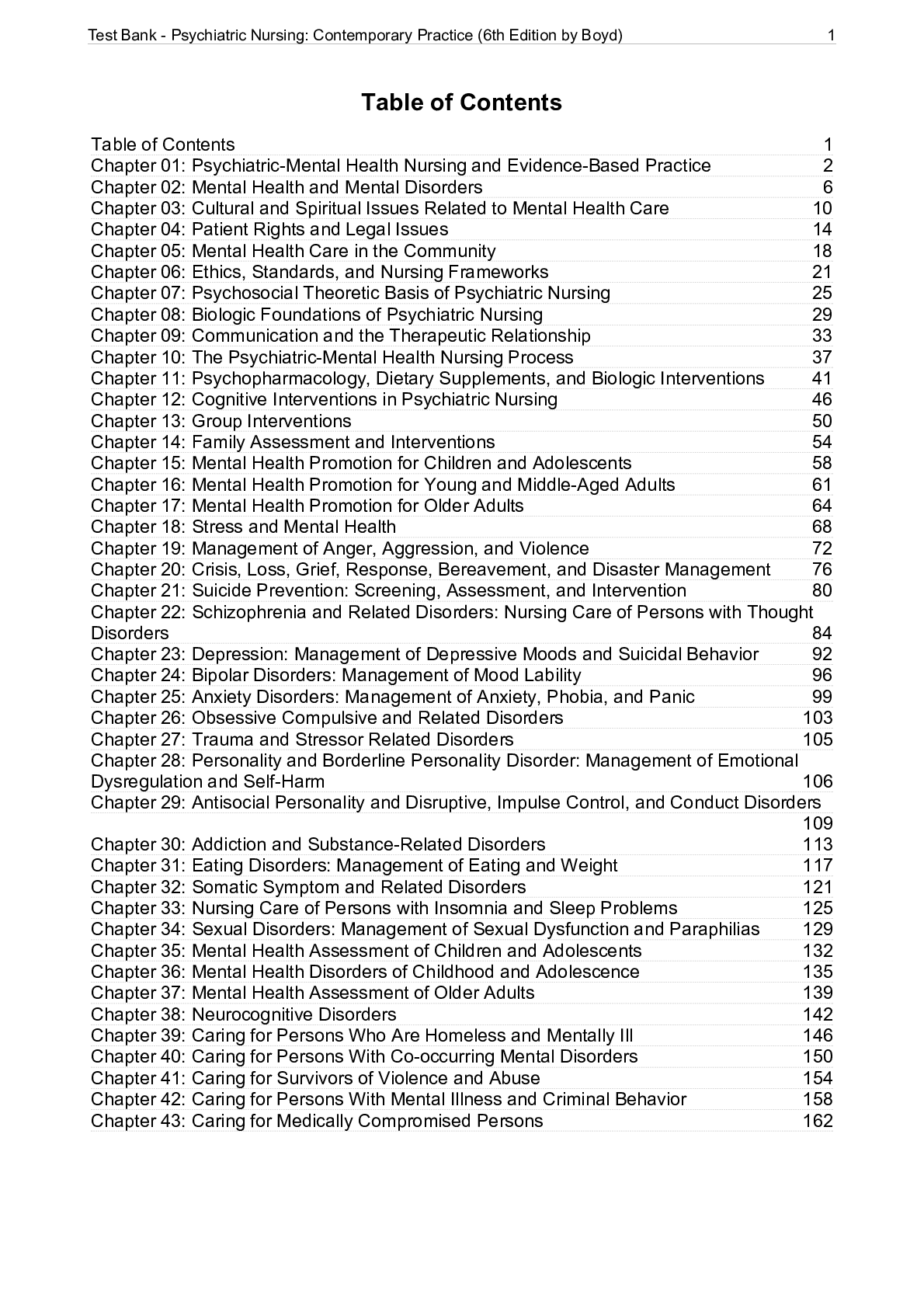
.png)
